Bibliothèque
Toutes les ressources
2061 – 2080 sur 2622 résultats
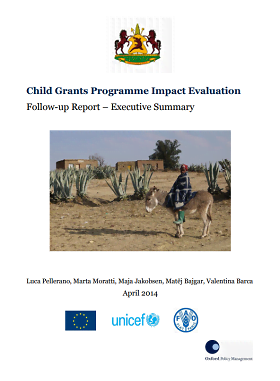
Child Grants Programme Impact Evaluation Follow-up Report – Executive Summary
Case Study
The Lesotho Child Grants Programme (CGP) is an unconditional social cash transfer targeted to poor and vulnerable households. It provides every quarter a regular transfer of between M360 and M7501 to poor households with children that are selected through a combination of Proxy Means Testing (PMT) and...

L’analyse de marché en situation d’urgence
Rapport
Malgré la quantité d’outils disponibles et d’innovations dans la conception de programmes, la communauté humanitaire fait face à certaines difficultés dans l’intégration des résultats d’analyses de marché dans la planification des programmes en situations de crise. Ce document...
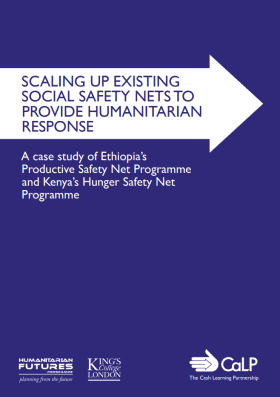
Scaling Up Existing Social Safety Nets to Provide Humanitarian Response: A case study of Ethiopia’s Productive Safety Net Programme and Kenya’s Hunger Safety Net Programme
Policy paper
A case study of Ethiopia’s Productive Safety Net Programme and Kenya’s Hunger Safety Net Programme. This thematic report has been undertaken as part of a 2013 research study entitled, Is Cash Transfer Programming ‘Fit for the Future’? The research was commissioned by the the CALP Network and...
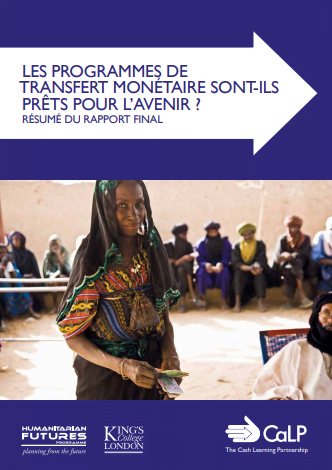
Les programmes de transfert monétaire sont-ils prêts pour l’avenir ? Résumé du rapport final
Rapport
Le présent résumé expose les résultats d’un travail de recherche mené en 2013 intitulé « Les programmes de transfert monétaire sont-ils prêts pour l’avenir ? ». Cette recherche a été commandée par le Cash Learning Partnership (the CALP Network) et menée par le Humanitarian Futures...

The Impact of Cash and Food Transfers: Evidence from a randomized intervention in Niger
Report
There is little rigorous evidence on the comparative impacts of cash and food transfers on food security and food-related outcomes. This paper assesses the relative impacts of receiving cash versus food transfers using a randomized design. Drawing on data collected in eastern Niger, the paper finds that...
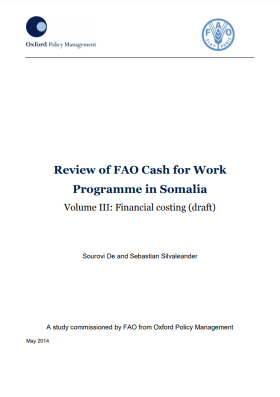
Review of FAO Cash for Work Programme in Somalia
Report
The objective of this costing study is to understand the absolute and relative magnitudes of various drivers of programme costs and to assess the cost-efficiency of the CFW Programme’s operations, using the total cost-to-transfer ratio (TCTR) for the programme which represents the total cost incurred by...
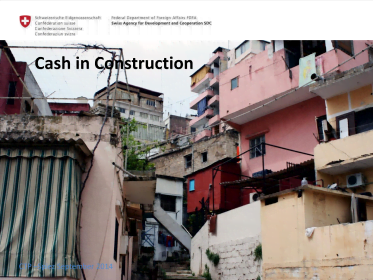
Cash in Construction
Presentation
This Powerpoint was used by SDC during a workshop on CTP and shelter/construction that took place in mid 2014. Click here to download a short introduction Powerpoint on Cash and Shelter from the same event.
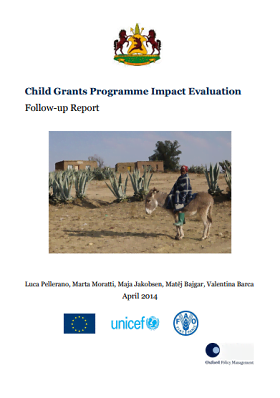
Child Grants Programme Impact Evaluation Follow-up Report
Report
The Lesotho Child Grants Programme (CGP) is an unconditional social cash transfer targeted to poor and vulnerable households. It provides every quarter a regular transfer of between M360 and M7501 to poor households with children that are selected through a combination of Proxy Means Testing (PMT) and...
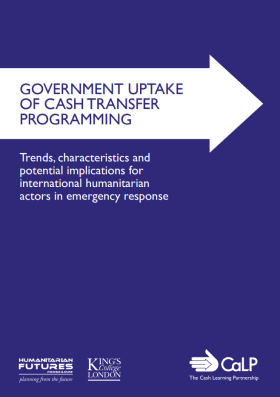
Government Uptake of Cash Transfer Programming: Trends, characteristics and potential implications for international humanitarian actors in emergency response
Policy paper
Trends, characteristics and potential implications for international humanitarian actors in emergency response. This thematic report has been undertaken as part of a 2013 research study entitled, Is Cash Transfer Programming ‘Fit for the Future’? The research was commissioned by the the CALP...
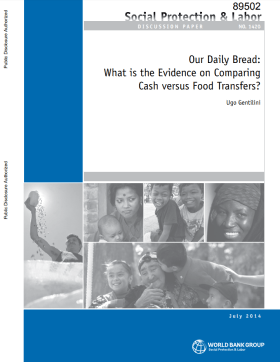
Our Daily Bread: What is the evidence on comparing cash versus food transfers?
Report
This paper reviews key issues in the ‘cash versus food’ debate, including as they relate to political economy, theory, evidence, and practice. In doing so, it benefited from a new generation of 12 impact evaluations deliberately comparing alternative transfer modalities. Findings show that...
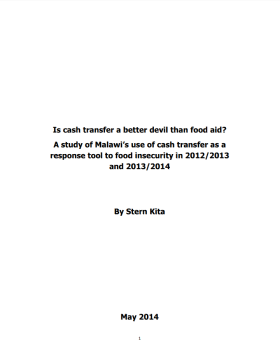
Is Cash Transfer a Better Devil than Food Aid? A study of Malawi’s use of cash transfer as a response tool to food insecurity in 2012/2013 and 2013/2014
Report
The 2004 Indian Ocean Tsunami is considered as the first humanitarian situation where cash transfers were used as an alternative to food aid. Since then, cash transfers have been used as a standalone response tool to disasters, or used in combination with food aid. Malawi piloted the use of cash...
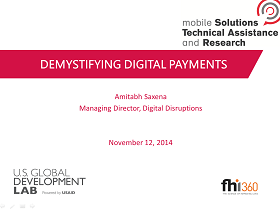
Demystifying Payments – mStar
Report
In its simplest form, a payment is any exchange of value between two parties, where usually Party A offers a form of currency in exchange for a good or service provided by Party B. The advent of nation-states issuing fiat currency, such as paper bills and bronze coins, which unlike gold or silver...
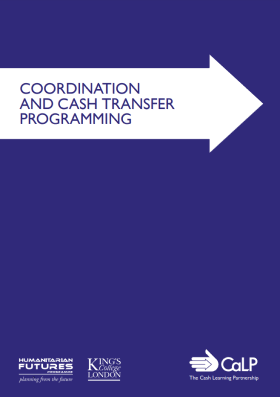
Coordination and Cash Transfer Programming
Policy paper
This thematic report has been undertaken as part of a 2013 research study entitled, Is Cash Transfer Programming ‘Fit for the Future’? The research was commissioned by the the CALP Network and undertaken by the Humanitarian Futures Programme (HFP), King’s College London. The overall...
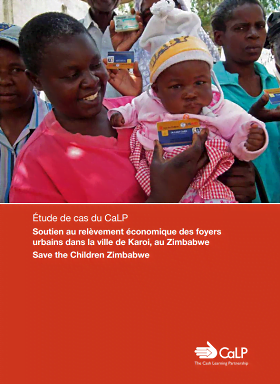
Étude de cas du CALP Network – Soutien au relèvement économique des foyers urbains dans la ville de Karoi, au Zimbabwe
Rapport
Dans la zone urbaine de Karoi, au Zimbabwe, Save the Children a allié des programmes d’argent contre travail au soutien des moyens de subsistance pour répondre aux besoins alimentaires immédiats et soutenir le relèvement économique des familles en situation de pauvreté. Le projet a utilisé des...

Testing Branchless Banking to Deliver Cash Transfers in Nepal
Policy paper
The Human Development Social Protection Pilot (HDSPP) is a sub-project of the joint UNDP-UNCDF Local Governance and Community Development Program (LGCDP). It has been initiated in two far-western districts in Nepal, Kanchanpur and Dhadheldura and it is being implemented by the Ministry of Federal Affairs...
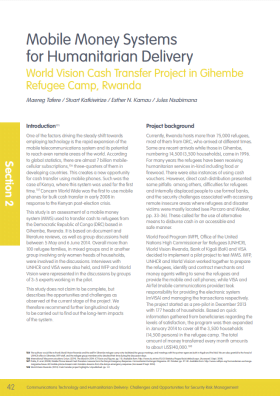
Mobile Money Systems for Humanitarian Delivery: World Vision cash transfer project in Gihembe refugee camp, Rwanda
Report
One of the factors driving the steady shift towards employing technology is the rapid expansion of the mobile telecommunications system and its potential to reach even remote areas of the world. According to global statistics, there are almost 7 billion mobilecellular subscriptions, three-quarters of them...

Information and communications technology response to the Liberia ebola crisis
Report
An information and communication technology assessment recently conducted in Liberia by NetHope and USAID addresses the potential for digital payments in the response to Ebola. The documents looks into the digital payments landscape, describing the banking sector, use of mobile money and remittance firms....

Financing of Cash Transfer Programming
Policy paper
This thematic report has been undertaken as part of a 2013 research study entitled, Is Cash Transfer Programming ‘Fit for the Future’? The research was commissioned by the the CALP Network and undertaken by the Humanitarian Futures Programme (HFP), King’s College London. The overall...

Does one size fit all? The Conditions for Conditionality in Cash Transfers
Presentation
Created in the early 1990s in Latin America, Conditional Cash Transfer programmes (CCTs) are now at the forefront of the international policy debate as one of the most effective social interventions for tackling poverty in developing countries. However, if CCTs have been successful in achieving some of...
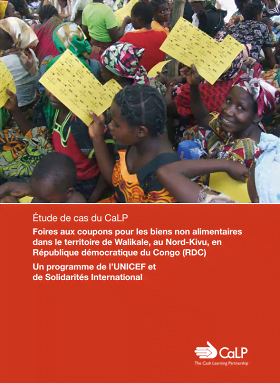
Étude de cas du CALP Network – Foires aux coupons pour les biens non alimentaires dans le territoire de Walikale, au Nord-Kivu, en République démocratique du Congo (RDC)
Case Study
Afin de répondre à une situation d’urgence soudaine, l’UNICEF et Solidarités International ont eu recours à une approche monétaire par le biais de coupons dans les villages de Nyasi et Bobolo, dans le territoire de Walikale, au Nord-Kivu, en République démocratique du Congo (RDC). Dans le...